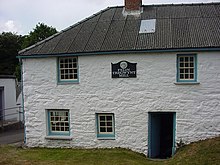Human settlement in Wales
Granston
| |
|---|---|
 St Catherine's Church St Catherine's Church | |
 | |
| OS grid reference | SM8934 |
| Community |
|
| Principal area | |
| Country | Wales |
| Sovereign state | United Kingdom |
| Police | Dyfed-Powys |
| Fire | Mid and West Wales |
| Ambulance | Welsh |
| |
Granston (Welsh: Treopert) is a hamlet and parish in Pembrokeshire, Wales. The parish was in the Hundred of Dewisland and includes the settlements of Llangloffan and Tregwynt, with Tregwynt woollen mill. Granston is in the community of Pencaer.
Name
The Welsh name of the hamlet, Treopert, suggests an association with a Robert, possibly Robert FitzMartin of Cemais. In 1292 the village was referred to (Latin) as "Villa Grandi", and in 1535 as "Grandiston" (Grand's Farm), possibly a reference to a French name, Grand.
History
Prehistoric remains were noted in the parish in 1920.
The earliest church records of the parish are from 1291 and 1326. The parish was attached to the crown after the Dissolution. There was an Episcopal court at Granston.
The size of the parish is 1,639 acres (6.63 km).
There are a number of listed buildings in the parish and, following the change from civil parishes to communities, Granston became part of the community of Pencaer.
Population
Granston parish in 1833 had a population of 195.
The population in 1872 was 156 people occupying 31 houses. Analysis of the 1881 census found that the four most frequently-occurring surnames in the parish (67 of 175 inhabitants) were Davies, Evans, Thomas and Williams.
Places of worship

The parish was annexed to that of Mathry and the church dedicated to St Catherine (sometimes recorded as Katherine), one of only three mediaeval churches in Wales to be dedicated to the saint. When the church was visited by the Royal Commission in 1920 it was found to have been constructed in 1877 with no evidence of the mediaeval structure save an octagonal font probably from the 14th century. However, the diocesan description notes that the foundations are mediaeval.
The parish includes the hamlet of Llangloffan, where there is a Baptist chapel. The original chapel was built in 1706, restored in 1749 and 1791 and rebuilt in 1862. There is no baptismal pool at the chapel, baptisms being performed at a specially constructed site in the Western Cleddau at Pont Llangloffan, south of the hamlet. Llangloffan is the name of a Welsh hymn melody (composer unknown).
Archives for both churches are kept by Dyfed Family History Society.
Tregwynt

Granston includes the estate of Tregwynt, whose papers are held by the Pembrokeshire Record Office. In the 14th century Sir William Horton of Tregwynt married the heiress to Candleston Castle. The Tregwynt Hoard, from the Civil War, was found at Tregwynt Mansion in 1996. The present Grade II*-listed manor house and extensions date from the 18th century.
Tregwynt mill (Melin Tregwynt) dates back to the 17th century when it served the surrounding area's sheep farming. It is still in operation, employing about 30 people, and in 2012 celebrated 100 years as a family business, now weaving for a global market. The mill featured in a BBC2 Wales Made in Wales episode in December 2012.
Llangloffan
Llangloffan hamlet is south of Granston. Close by the source of the Western Cleddau river, the 40 hectares (99 acres) Llangloffan Fen includes a 15.1 hectares (37 acres) National Nature Reserve and a Site of Special Scientific Interest (SSSI). Llangloffan lends its name to a range of Welsh farmhouse cheeses; the brand was acquired by Carmarthenshire Cheese Company in 2006.
References
- ^ "North Dewisland Benefice: Granston". Retrieved 23 April 2015.
- Mills, A. D. (2011). A Dictionary of British Place Names. Oxford University Press. ISBN 9780199609086. Retrieved 15 May 2015.
- ^ Royal Commission on the Ancient and Historical Monuments of Wales. HMSO. 1925. p. 101. Retrieved 23 April 2015.
- ^ "A Vision of Britain: Granston". Retrieved 23 April 2015.
- "British listed buildings: Pencaer". Retrieved 23 April 2015.
- ^ "GENUKI: Granston". Retrieved 23 April 2015.
- "British surnames: Granston". Retrieved 23 April 2015.
- Cartwright, Jane (2008). Feminine Sanctity and Spirituality in Medieval Wales. University of Wales. p. 158. ISBN 9780708319994. Retrieved 23 April 2015.
- "GENUKI parish maps". Retrieved 23 April 2015.
- "Welsh Religious Buildings Trust: Llangloffan Welsh Baptist Church". Retrieved 23 April 2015.
- "Hymnary: Llangloffan". Retrieved 23 April 2015.
- "Dyfed FHS: Granston". Retrieved 23 April 2015.
- "Pembrokeshire Record Office: Harries Family of Priskilly, Heathfield and Tregwynt Papers". Retrieved 23 April 2015.
- Royal Commission on Ancient and Historical Monuments in Wales (30 April 2000). An Inventory of the Ancient Monuments in Glamorgan. RCAHMW. p. 409. ISBN 978-1-871184-22-8. Retrieved 23 April 2015.
- "British listed buildings: Tregwynt". Retrieved 23 April 2015.
- Cadw. "Tregwynt (Grade II*) (12296)". National Historic Assets of Wales. Retrieved 25 July 2019.
- Cadw. "North Wing & Low Farm Range to W.of Tregwynt (Grade II*) (12997)". National Historic Assets of Wales. Retrieved 25 July 2019.
- "Tregwynt Woollen Mill". Archived from the original on 19 April 2015. Retrieved 23 April 2015.
- "100 years of Welsh weavers Melin Tregwynt". Wales online. 22 September 2012. Retrieved 23 April 2015.
- "Made in Wales - Melin Tregwynt (video clip)". Retrieved 23 April 2015.
- "Pembrokeshire Rivers Trust: Llangloffan Fen". Retrieved 23 April 2015.
- "The Wildlife Trust of South and West Wales: Llangloffan Fen". Retrieved 23 April 2015.
- "Countryside Council for Wales: Corsydd Llangloffan". Archived from the original on 18 May 2015. Retrieved 23 April 2015.
- "Fen-tastic reserve pulls in the wildlife". PLANED. 2011. Retrieved 23 April 2015.
Further reading
- Coggins, Julie. The History of Tregwynt Woollen Mill. Journal of the Pembrokeshire Historical Society 21 (2012): 28-34
- Coggins, Julie. Weaving a legacy: The history of Tregwynt Woollen Mill, 100 years old in 2012. Pembrokeshire Life September 2011: 20-21